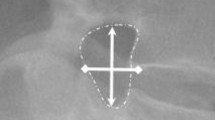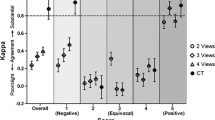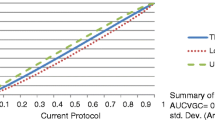Abstract
Powers ratio, as assessed on plain radiographs or computed tomography (CT) images, appears to have clinical and prognostic value. To date, the validation of this assessment tool has been limited to a small number of observers at a single site. No study has examined the intraobserver reproducibility and interobserver reliability of the Powers ratio measurement on plain radiographs or CT images among a large cohort of spine surgeons. This type of validation is critical to allow for the broader use of the Powers ratio methodology in research studies and clinical applications. Plain radiographs and spiral CT images of the cervical spine of 32 patients were assessed, and the Powers ratio was determined by five spine surgeons. Each surgeon performed three readings, 7 months apart. In the first round of measurements, the observers used only the Powers’ method of instruction. The second and third measurement sets were obtained after an interactive teaching session on the methodology. The order of the images was altered for the second and third set of measurements. The coefficient of variation (Cv) was calculated to determine the intraobserver repeatability and interobserver reliability for each imaging technique. A Bland-Altman plot was then used to assess the agreement between the two imaging techniques. For interobserver reliability, the mean Cv of the Powers ratio was 9.09 and 4.31% for plain radiographs and CT, respectively. The Cv mean value for intraobserver reproducibility averaged 4.95% (range 1.39–9.08) when CT scans were used and 14.17% (range 7.54–34.30) when plain radiographs were used. For intraobserver reproducibility, the lowest and highest Cv mean value of five raters was 1.39 and 9.08% using CT scans and 7.54 and 34.3% using plain radiographs. The Bland-Altman plot, demonstrated that the two methods were in close agreement on the −0.8 and 0.89% interval for limits of agreement (bias ± 1.96σ). The intraobserver reproducibility and interobserver reliability of Powers ratio measurement was acceptable (<5%) with CT scans but not with plain radiographs. However, despite the statistically inferior reliability and repeatability, the Bland-Altman plot analysis showed that given the −0.8 and 0.89% limits of agreement, the two methods may be used interchangeably in clinical practice.



Similar content being viewed by others
References
Bland JM, Altman DG (1986) Statistical methods for assessing agreement between two methods of clinical measurement. Lancet 1(8476):307–310
Dziurzynski K, Anderson PA, Bean DB, Choi J, Leverson GE, Marin RL, Resnick DK (2005) A blinded assessment of radiographic criteria for atlanto-occipital dislocation. Spine 30(12):1427–1432. doi:10.1097/01.brs.0000166524.88394.b3
Fehlings MG et al (2006) Interobserver and intraobserver reliability of maximum canal compromise and spinal cord compression for evaluation of acute traumatic cervical spinal cord injury. Spine 31(15):1719–1725. doi:10.1097/01.brs.0000224164.43912.e6
Fleiss JL (1981) Statistical methods for raters and proportions, 2nd edn. Wiley, New York, pp 212–236
Gaa J, Deininger HK (1989) Traumatic atlanto-occipital dislocation in conventional x-ray diagnosis. Radiologe 29(7):354–358
Hamai S, Harimaya K, Maeda T, Hosokawa A, Shida J, Iwamoto Y (2006) Traumatic atlanto-occipital dislocation with atlantoaxial subluxation. Spine 31(13):E421–E424. doi:10.1097/01.brs.0000220224.01886.b3
Karol LA, Sheffield EG, Crawford K, Moody MK, Browne RH (1996) Reproducibility in the measurement of atlanto-occipital instability in children with Down syndrome. Spine 21(21):2463–2467. doi:10.1097/00007632-199611010-00010 (discussion 2468)
Kuzma BB, Goodman JM (1997) Diagnosis of atlanto-occipital dislocation. Surg Neurol 48(4):418–419. doi:10.1016/S0090-3019(97)00396-0
Powers B, Miller MD, Kramer RS, Martinez S, Gehweiler JA Jr (1979) Traumatic anterior atlanto-occipital dislocation. Neurosurgery 4(1):12–17. doi:10.1097/00006123-197901000-00004
Saeheng S, Phuenpathom N (2001) Traumatic occipitoatlantal dislocation. Surg Neurol 55(1):35–40. doi:10.1016/S0090-3019(00)00350-5 (discussion 40)
Wellborn CC, Sturm PF, Hatch RS, Bomze SR, Jablonski K (2000) Intraobserver reproducibility and interobserver reliability of cervical spine measurements. J Pediatr Orthop 20(1):66–70. doi:10.1097/00004694-200001000-00015
Author information
Authors and Affiliations
Corresponding author
Rights and permissions
About this article
Cite this article
Li, G., Passias, P., Kozanek, M. et al. Interobserver reliability and intraobserver reproducibility of powers ratio for assessment of atlanto-occipital junction: comparison of plain radiography and computed tomography. Eur Spine J 18, 577–582 (2009). https://doi.org/10.1007/s00586-008-0877-5
Received:
Revised:
Accepted:
Published:
Issue Date:
DOI: https://doi.org/10.1007/s00586-008-0877-5




